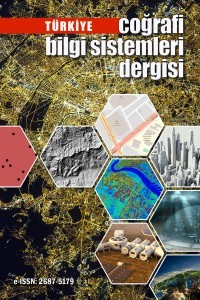30 Years of Geographic Information Systems Studies in Turkey: A Bibliometric Analysis
Bibliometric Analysis, Literature Analysis, Geographic Information Systems (GIS), VOSviewer, VOSviewer, Turkey
30 Years of Geographic Information Systems Studies in Turkey: A Bibliometric Analysis (1990-2020)
Bibliometric Analysis, Literature Analysis, Geographic Information Systems (GIS), VOSviewer, Turkey,
___
- Akgün A & Bulut F (2007). GIS-based landslide susceptibility for Arsin-Yomra (Trabzon, North Turkey) region. Environmental geology, 51(8), 1377-1387. https://doi.org/10.1007/s00254-006-0435-6
- Artsın M (2020). A Text Mining Application: VOSviewer Eskişehir Technical University Journal of Science and Technology B - Theoretical Sciences 8(2), 334–354.
- Ateş E, Öncü M A, Bayar R & Yilmaz M (2020) Analysis of Eskişehir Urban Land Expansion With Cellular Automata and CAMarkov chains (1984-2056). Turkish Journal of Geographical Sciences, 18(2), 276-295. https://doi.org/10.33688/aucbd.803432
- Değerliyurt M & Çabuk S (2015). Defining the Geography by Geographical Informatıon Systems. Eastern Geographical Review, 20(33), 37-48. https://doi.org/10.17295/dcd.88722
- Duan P, Wang Y & Yin P (2020). Remote sensing applications in monitoring of protected areas: A bibliometric analysis. Remote Sensing, 12(5), 772. https://doi.org/10.3390/rs12050772
- Ercanoglu M & Gokceoglu C (2002). Assessment of landslide susceptibility for a landslide-prone area (north of Yenice, NW Turkey) by fuzzy approach. Environmental geology, 41(6), 720-730. https://doi:10.1007/s00254-001-0454-2
- Erdogan S, Yilmaz I, Baybura T & Gullu M (2008). Geographical information systems aided traffic accident analysis system case study: city of Afyonkarahisar. Accident Analysis & Prevention, 40(1). https://doi.org/10.1016/j.aap.2007.05.004
- Evren S & Kozak N (2014). Bibliometric analysis of tourism and hospitality related articles published in Turkey. Anatolia, 25(1), 61-80. https://doi.org/10.1080/13032917.2013.824906
- Garousi, V. (2015). A bibliometric analysis of the Turkish software engineering research community. Scientometrics, 105(1), 23-49. https://doi:10.1007/s11192-015-1663-x
- Güney İ & Somuncu M (2020). New trends in tourism geography: A network analysis using bibliometric indicators. Aegean Geographical Journal, 29 (2), 297-319.
- Güzeller C O & Çeliker N (2018). Bibliometric analysis of tourism research for the period 2007-2016. Advances in Hospitality and Tourism Research, 6(1), 1-22. https://doi.org/10.30519/ahtr.446248
- Kocak M, García-Zorita C, Marugán-Lázaro S, Çakır M P & Sanz-Casado E (2019). Mapping and clustering analysis on neuroscience literature in Turkey: A bibliometric analysis from 2000 to 2017. Scientometrics, 121(3), 1339-1366. https://doi.org/10.1007/s11192-019-03259-w
- Kurutkan M N & Orhan F (2018). Bibliometric Analysis of Quality Principles by Visual Mapping Technique (Original name: Kalite Prensiplerinin Görsel Haritalama Tekniğine Göre Bibliyometrik Analizi – in Turkish). Sage Publisher, ISBN: 978-605-184-089-5.
- Liu F, Lin A, Wang H, Peng Y & Hong S (2016). Global research trends of geographical information system from 1961 to 2010: a bibliometric analysis. Scientometrics, 106, pp.751-768. https://doi.org/10.1007/s11192-015-1789-x
- Özcan C, Yılmaz E, Lafcı B, Küçükpehlivan T, Aksoy T, Ağaçsapan, & Sarı S (2021). Historical Development and Current Situation of Geographical Information Systems in Turkey. GSI Journals Serie C: Advancements in Information Sciences and Technologies, 4 (1), 33-61. https://dergipark.org.tr/en/pub/aist/issue/56936/836363
- Süzen M L & Doyuran V (2004). A comparison of the GIS based landslide susceptibility assessment methods: Multivariate versus bivariate. Environmental Geology, 45(5), 665-679. https://doi.org/10.1007/s00254-003-0917-8
- Şener E, Davraz A & Ozcelik M (2005). An integration of GIS and remote sensing in groundwater investigations: A case study in Burdur, Turkey. Hydrogeology Journal, 13(5-6), 826-834. https://doi:10.1007/s10040-004-0378-5
- Şimşek B & Bakır S (2016). International Students Mobility and the Internationalization Process of Atatürk University. Journal of Turkish Research Institute, 0(55), 509-542.
- Tian Y, Wen C & Hong S (2008). Global scientific production on GIS research by bibliometric analysis from 1997 to 2006. Journal of Informetrics, 2(1), 65-74. https://doi.org/10.1016/j.joi.2007.10.001.
- Tindall D B & Wellman B (2001). Canada as social structure: Social network analysis and Canadian sociology. Canadian Journal of Sociology/Cahiers canadiens de sociologie, 265-308.
- Van Eck N J & Waltman L (2010). Software survey: VOSviewer, a computer program for bibliometric mapping. Scientometrics, 84(2), 523-538. https://doi.org/10.1007/s11192-009-0146-3
- Yalcin A, Reis S, Aydinoglu A C & Yomralioglu T (2011). A GIS-based comparative study of frequency ratio, analytical hierarchy process, bivariate statistics and logistics regression methods for landslide susceptibility mapping in Trabzon, NE Turkey. Catena, 85(3), 274-287. https://doi.org/10.1016/j.catena.2011.01.014
- Yalcin H & Yayla K (2016). Main dynamics of folklore discipline: A scientometric analysis. Milli Folklor, (112), 42-60.
- Yanık C & Öztürk M (2014). An Assessment on the Transformation on Social Movements. Mukaddime, 5(1), 45-63.
- Yomralioglu T (2000). Coğrafi bilgi sistemleri temel kavramlar ve uygulamalar – in Turkish). Istanbul, Turkey: Seçil Ofset. ISBN: 975-97369-0-X
- Başlangıç: 2019
- Yayıncı: Lütfiye KUŞAK
Seda Nur Gamze HAMAL, Ali ULVİ
30 Years of Geographic Information Systems Studies in Turkey: A Bibliometric Analysis
Merve ALTUNDAL ÖNCÜ, Ersin ATEŞ, Seçkin FİDAN, Mutlu YILMAZ
Sacit MUTLU, İshak CİNDİOĞLU, Ahmet Özkan KUL, Azad SAĞLAM SELÇUK
Aydın İli Biyoklimatik Konfor Şartlarının Turizm Konfor İndeksi ile Analizi
Betül Gülay KAYA, Şenay GÜNGÖR
Dijital Orman Kadastro Harita Çizimi İçin Makro Yazılım Geliştirilmesi
